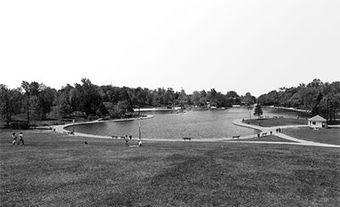Rattenbury emigrated to Canada in 1892, first working as agent for Bradford investors in Vancouver. He had articled in an uncle's Leeds firm, Lockwood and Mawson, gaining experience in commercial and civic design, structural systems, architectural historical vocabulary and office practice.
Aided by his prize-winning ability as draftsman, Rattenbury quickly supplanted the earlier generation of immigrant architects in the province. He won the 1893 competition for the new Provincial Legislature in Victoria with a scheme that combined effective planning with impressive articulation, neatly expressing the Imperial connection but also reflecting contemporary American taste. Despite cost overruns, the Legislature was opened in 1898 to considerable praise since it represented the metropolitan ambitions of the settler society.
Rattenbury's demonstrated competence at architectural display won him patronage from the leading institutions as well as government. Important commissions included branches for the Bank of Montreal (1895-1900, including the acquisition of his handsome Merchant's Bank, Victoria, 1906-1907); and facilities for the Canadian Pacific Railway ranging from additions at their Rocky Mountain resorts (1901-1904) and Vancouver Hotel (1902-1908), Mount Stephen House Hotel, Field, BC (1902-1903), Empress Hotel, Victoria (1905-1908), International Cable Station at Bamfield, BC (1902-1903) to the Victoria Steamship Terminals (1904 and 1923-26, with P.L. James). Besides several attractive Arts-and-Crafts houses in Victoria, he also designed cold storage depots in the interior of BC and a mansion in Calgary (1903) for the cattle rancher Pat Burns, together with provincial courthouses at Chilliwack (1894), Nanaimo (1896), Victoria (refurbishment, 1899), Nelson (1905-06) and Vancouver (1906-1911, with an addition by Thomas Hooper).
He was especially adept at manipulating the fashionable Scots Baronial - cum - Château and Beaux-Arts styles, the latter most effectively for the Vancouver Courthouse (adapted by Arthur ERICKSON Architects 1978-83 for the Vancouver Art Gallery) and Provincial Library addition to the Legislature (1911-13, originally to have included a new Provincial Museum and Government Printing Office).
Rattenbury's commercial ventures were complicated and included many spectacular beginnings turned to failures. They included the provision of pre-fabricated steamers for the Klondike Gold rush (1898-1900), construction-related businesses as well as substantial land purchases in northern BC These foundered due largely to the economic and societal disruption caused by WWI. The subsequent collapse of the Grand Trunk Pacific Railway, for which he had devised a series of grand Scots Baronial and Beaux-Arts projects 1908-1914, meant that only the foundations of the massive Hotel Prince Rupert were dug in 1914.
Rattenbury's main contribution to architecture in BC was not in the originality of his designs but rather his ability to bring a new level of sophistication to architectural imagery there - one which satisfied the aspirations of the province at a crucial time in its political development. His buildings, which made use of Rattenbury's strong command of architectural vocabulary, reflected Imperial connections and raised the level of building technology and craftsmanship.
After 1918 Rattenbury secured few commissions, being preoccupied with litigation against provincial acquisition of his northern lands for veteran resettlements. Nevertheless his work for the CPR - the Crystal Gardens (1921-25) and Secord Steamship Terminal in Victoria - exhibit his continuing command of civic and ornamental design.
Hastened by scandal attaching to his divorce and remarriage, Rattenbury returned to Britain in 1929. He was murdered by his chauffeur, who was his second wife's lover, in 1935.

 Share on Facebook
Share on Facebook Share on X
Share on X Share by Email
Share by Email Share on Google Classroom
Share on Google Classroom




